#Flutterflow Web App
Explore tagged Tumblr posts
Text
Build Your Dream App FAST with Flutterflowdevs – The #1 Flutterflow Development Company
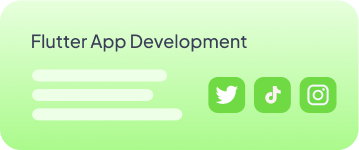
Are you tired of waiting months—or even years—to launch your mobile or web app? Do you want a cutting-edge, high-performance app built in record time without breaking the bank? Then stop searching because Flutterflowdevs is here to make your app dreams a reality!
As the leading Flutterflow Development Company, we specialize in blazing-fast app development with zero compromises on quality. Whether you’re an entrepreneur with a groundbreaking idea, a startup looking to scale, or a business eager to digitize, we are your one-stop solution to building apps that dominate the market. But act fast—every day you wait is a missed opportunity to launch, grow, and succeed!
Why Choose Flutterflowdevs?
In the world of app development, speed and quality are everything. But traditional coding takes months of development, extensive testing, and huge budgets. That’s where Flutterflowdevs changes the game!
With our expertise in Flutterflow, we deliver stunning, high-functioning mobile and web apps up to 10X faster than traditional development. The best part? No sacrifice in quality, scalability, or performance!
Here’s why businesses and entrepreneurs trust Flutterflowdevs, the top Flutterflow Development Company:
1. Speed That Gives You a Competitive Edge
Time is money. While others are still stuck in endless development cycles, you could already be live in the market, attracting users, and generating revenue.
We utilize Flutterflow’s powerful no-code and low-code solutions to build visually stunning, feature-rich apps at lightning speed. Weeks instead of months—yes, you read that right!
Stop wasting time. The faster you launch, the sooner you start winning!
2. Cost-Effective Without Compromising Quality
Hiring a traditional development team? Prepare to spend tens of thousands of dollars and wait months for results. But with Flutterflowdevs, you get world-class apps at a fraction of the cost.
How do we do it?
No excessive coding hours
No massive developer teams draining your budget
No unexpected delays
Just ultra-fast, budget-friendly development that gives you maximum ROI.
3. Fully Customizable Apps That Stand Out
Think no-code means basic? Think again! With Flutterflow, customization is limitless.
Our team of expert Flutterflow developers can create: Eye-catching UI/UX designs Powerful integrations (APIs, databases, payments & more) Scalable apps ready for massive growth Seamless web and mobile app functionality
Your app should look, feel, and function exactly how you imagine—and we make that happen.
4. Get Ahead With Future-Proof Technology
Technology is evolving at breakneck speed. If your business isn’t adapting, it’s falling behind.
Flutterflow isn’t just another tool—it’s the future of modern, scalable, and efficient app development. Big brands and industry leaders are already shifting towards low-code and no-code development. If you’re not on board, you’re missing out on a huge opportunity.
Don’t get left behind. Work with the best Flutterflow Development Company today!
5. End-to-End Support – We’re With You Every Step
At Flutterflowdevs, we don’t just build your app and leave you hanging. We provide:
Strategy & Consulting – We refine your app idea into a market-ready success Custom Development – Tailored features that set your app apart Maintenance & Support – Continuous updates and fixes to keep your app running smoothly Growth Optimization – Scaling strategies to drive users & revenue
You’re never alone in your journey. Our experts guide you from idea to launch—and beyond!
Who Is This For?
Still wondering if Flutterflowdevs is the right fit for you? If you fall into any of these categories, you need to take action NOW:
Startups – Get your MVP launched fast and secure funding Entrepreneurs – Bring your app idea to life without coding headaches Businesses – Digitize your operations and reach more customers E-commerce Owners – Build a stunning shopping app that drives sales
If you’ve been thinking about launching an app, today is the day to act!
Act Fast – Your Competitors Won’t Wait!
Every second you delay, someone else is launching their app, gaining users, and taking over the market.
Don’t let them steal your success.
At Flutterflowdevs, we’re helping businesses and visionaries like you turn their ideas into powerful, revenue-generating apps—FAST.
But here’s the catch: Our slots fill up quickly. We only take on a limited number of projects to ensure we provide the best service possible.
Ready to Build Your Dream App? Let’s Get Started!
This is your moment. The opportunity is right in front of you. All you have to do is take the first step.
Contact Flutterflowdevs now and let’s turn your app idea into reality—before someone else beats you to it!
Read More:Hire Flutterflow Expert Hire Supabase Developer MVP Development in Flutterflow
0 notes
Text
How to Create An App and Make Money in 2024

Mobile applications have emerged as a critical business tool, providing businesses with another platform for sales generation, service enhancement, and income creation. The emergence of these mini devices has started eclipsing the use of powerful desktop/laptop devices, and hence, faster development of mobile applications has occurred.
Whether your goal is to improve services or sell products, the ultimate objective is often to make money from apps. On the other hand, there ought to be a well-conceived plan even before one sets out to develop an application.
This article describes the entire process of creating a mobile application with income-generating goals. If you don’t know how to proceed with the steps of developing an app, do not worry, as we have already done a comprehensive write-up on how to build a mobile app.
What’s the need of this guide?
A lot of people think their businesses will start making money the moment they take them online. But that is not true. The online market is as much competitive as the physical one. Therefore, when design, development, and marketing of such an application is carried out, the assumption of being present alone is not enough.
We have compiled useful information for people interested in making money from application creation. This guide will include popular monetization models for mobile developers to consider.
Let’s start with how to earn money by developing a mobile application. There are four ways to earn money with mobile application development.
How do You Make Money by Creating an App?
Mobile app development has become a lucrative field, with numerous opportunities to earn money through various monetization methods. The upcoming section will explore popular strategies for generating revenue from your mobile apps.
Whether you’re a third-party service provider or aiming to sell services directly through your app, choosing the right monetization approach is crucial. The success of your app’s revenue generation depends on aligning your monetization strategy with the type of app you’re developing.
When you develop a mobile app, you can choose different monetization options to start earning money. You can make money through the following methods. If you are not selling any services or products, then you can still earn money. Let’s look at some popular ways to earn money with mobile app development.
Application Development Platforms

Native Development Platforms
iOS (Swift/Objective-C): This platform is specifically for developing applications for Apple devices. It offers high performance and access to all device features, but requires separate codebases for iOS and Android.
Android (Java/Kotlin): Similar to iOS, Android development allows for deep integration with device features. However, it also requires managing two codebases for cross-platform functionality.

Cross-Platform Development Tools
React Native: Developed by Facebook, React Native allows developers to use JavaScript to build mobile applications for both iOS and Android. It combines the performance of native apps with the efficiency of web technologies.
Flutter: Google’s Flutter uses the Dart programming language to create natively compiled applications for mobile, web, and desktop from a single codebase. It is known for its expressive UI and fast performance.
No-Code/Low-Code Platforms
Adalo: Adalo is a user-friendly platform that allows you to build native apps for iOS and Android without writing code. It offers a wide range of templates and components to help you create visually appealing apps.
Bubble: Bubble is another no-code platform that enables users to create web applications with drag-and-drop functionality, focusing on rapid development and deployment.
FlutterFlow: This platform leverages Flutter’s capabilities to provide a visual interface for building cross-platform apps. It offers a drag-and-drop builder and integrates with Firebase for backend services.
Looking for a Mobile App Development Partner? We’re Here to Help!
Creating a app and monetizing it requires a strategic approach. Start by identifying a problem that your app can solve and targeting a specific audience. Design a user-friendly interface and prioritize performance.
If you’re looking to build a custom mobile app to earn money, look no further! Brilworks offers cost-effective mobile development services across various industries, including healthcare, fintech, media, and entertainment.
To Learn More, Read This Article:
0 notes
Text
How to Master Web and Mobile Development in 6 Months
The time it takes to learn Flutterflow, Flutter, and Dart depends on your existing programming experience, daily commitment, and learning method. Since you mentioned being a fairly brilliant guy with strong interest, here’s a rough estimate of how long it might take, assuming a 3-5 hours per day commitment: 1. Flutterflow (No-Code/Low-Code App Builder) Learning Curve: Easy to Moderate. Estimated…
0 notes
Text
The Future of Low-Code Development: Flutterflow's Evolution
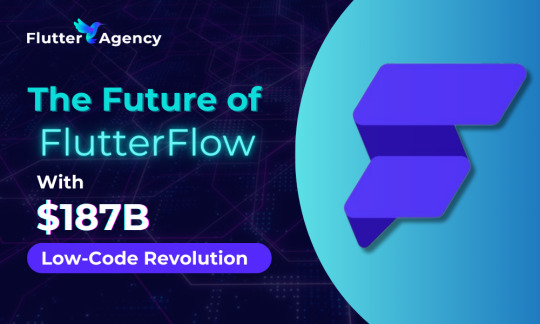
Low-code platforms have become a game-changer, especially for startups with speedy launches in mind in the fast-paced global software development scenario.
These platforms help in building apps with the use of visual interfaces and drag-and-drop tools that provide an easier environment to develop applications reducing the prevalence of conventional coding knowledge.
Especially beneficial for smaller startups with fewer resources, this method allows businesses to develop and deploy mobile apps quickly, iterate rapidly fast as well, and help merchants concentrate on innovation over complex code.
Nothing beats low-code in the modern way we develop software! Since there is a lot of pressure on startups to meet tight deadlines and budget constraints, these platforms have only helped in saving time.
Low-code development reduces the technical barriers to entry, enabling more people – from full-time developers and citizen creators alike — to be involved in creating apps, leading us towards a broader view of what an agile developer looks like.
Flutterflow is a great example of the things happening in low-code development. Developed on Google's Flutter framework, users can build fully functional mobile applications without the need to write long lines of code using the app-building platform—Flutterflow.
With its simple UI, it comes with features that make it great in mobile app development especially for startups. In addition to speeding up your workflow, Flutterflow gives you the ability to drop in custom code whenever needed which will remedy any inefficiencies pent-up from using visual tools while designing in a way that remains easy enough accessible for beginners.
With the mobile app development for startups demand growing ever larger, Flutterflow comes through as a wind of stiff breeze in a low code world balancing being user-friendly and feature-rich.
Low-Code Platforms Going Mainstream
Factors Behind Increasing Low-Code Adoption
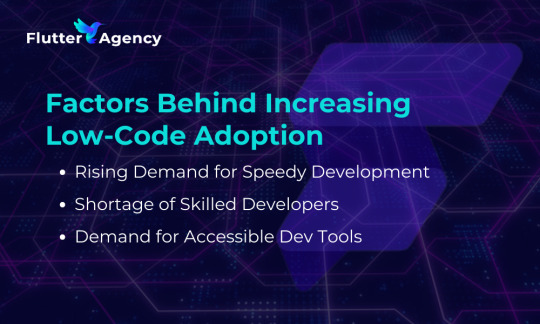
Some of the key trends that are driving the rise in low-code platforms, including mobile app development for a startup:
Increasing Demand for Faster Development Cycles: Startups have to get their products out in the market faster or face losing out on business. This enables low-code platforms for quick prototyping and deployment, which helps to reduce time-to-market.
Shortage of Skilled Developers: There is a shortage of developers, with great demand for software solutions. Low-code platforms map to this inverse need, allowing less technical users the ability to build basic yet functional applications.
Need for More Accessible Development Tools: Inclusion of non-developers and business users in the development process. Low-code platforms are created for the non-technical user.
Benefits of Low-Code Development
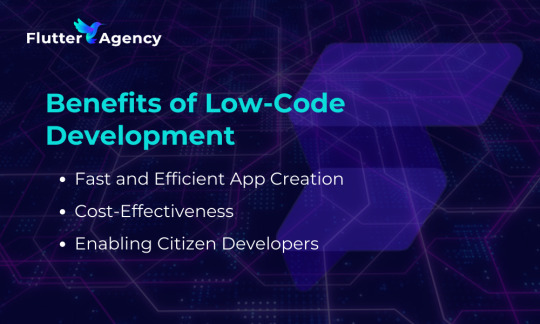
Speed and Efficiency in App Creation: Low-code platforms provide a way to streamline app development, which allows you faster creation (and iteration) of mobile apps — an absolute necessity for startups.
Cost-Effectiveness: As the low-code platforms tend to lower down all that extensive coding and specialized skills needs, it becomes a cost-effective technology for startups.
Empowering Citizen Developers: Low-code tools empower citizen developers to get involved in app development, therefore applying innovation that might not have been viewed otherwise — enabling startups with a broader set of ideas and skills.
Why Flutterflow Stands Out
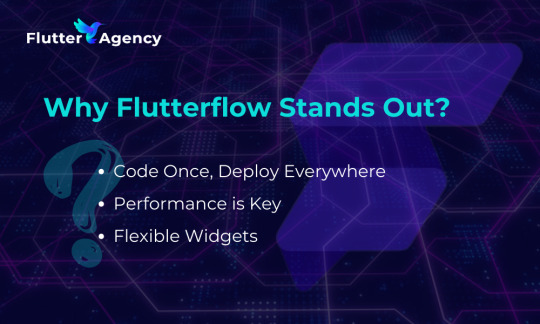
Integration with Flutter
Flutter —(made by Google) is a popular native UI toolkit for cross-platform development on Mobile, Web, and Desktop
Its benefits include:
Write Once, Deploy Anywhere: need to write platform-specific code in one shared library.
Performance is Key: Flutter provides 60-120 fps animations and fast responses to user input, delivering a superior app experience.
Flexible Widgets: It comes with a rich set of flexible widgets that helps you to develop polished and customized UI.
Building on these capabilities, Flutterflow is a low-code platform that preserves the strengths of Flutter as well as makes app development even more accessible.
Because of Flutter's powerful framework, making a quality mobile app with minimal coding expertise is made possible by Flutterflow; great for startups wanting to develop mobile apps.
Key Features of Flutterflow

Visual Development Environment: Provides an easy-to-use drag-and-drop interface that makes creating Android Applications as easy and quick as possible.
Building with Custom Code: Flutterflow has made it easy to build without any code, however, for added flexibility and functionality custom coding can always be integrated.
Pre-Built Templates and Components: Some various in-build templates and components will help you to fasten the process of development which results consistently in one place with the user interface.
Real-Time Collaboration and Feedback: While collaborating in real-time, teams readily iterate on designs and implement changes faster.
Use Cases
Examples of Flutterflow Projects Built Efficiently
A startup rapidly launching an MVP for a mobile app, reducing development time from months to weeks.
A non-profit organization creating an app to engage its community without needing a full development team.
Types of Industries that will be Benefitted by Flutterflow
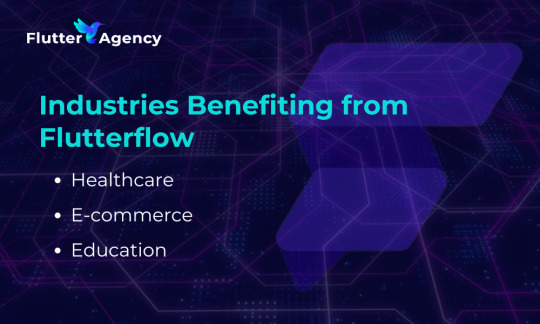
Healthcare: For rapid patient management applications or telemedicine solutions.
E-commerce: To quickly launch their mobile shopping platforms used for startups.
Education: Interactive learning tools and platforms that need quick iteration + deployment.
With all the powerful features mentioned above and greater versatility, Flutterflow is an excellent choice for any startups or businesses willing to make their custom mobile app development less complicated.
What Is the Future of Flutterflow in Low-Code Development
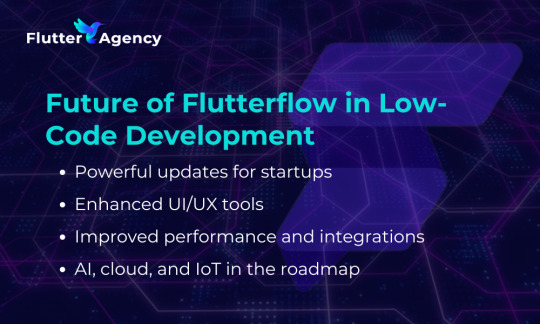
Upcoming Features and Roadmap
However, as Flutterflow continues to grow other interesting updates are going to be introduced over time making it powerful, especially for mobile app development startups.
It is expected that future updates will continue to enhance the platform by providing powerful UI/UX design tools, improving performance, and extending integration with third-party services. These new features should make Flutterflow even more powerful and easier to work with.
A roadmap might also include tighter integration with cloud services, AI-based development assistance, and extended platform support like wearables or IoT. You can create fantastic new tools and integrations that help startups build applications, which keeps you ahead of the competition.
How It Affects the Developer Ecosystem
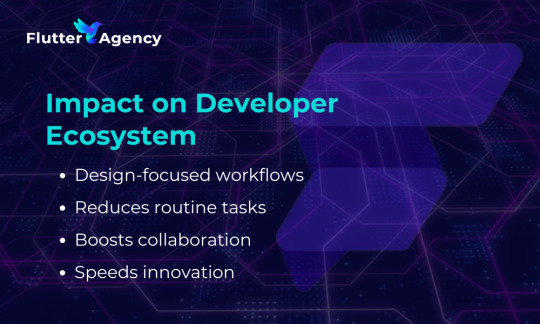
Flutterflow has the potential to disrupt the status quo of traditional development practices and move the needle for the developer ecosystem.
As low code is getting steam and platforms like Flutterflow are growing, this may lead to moving the field from manual coding towards design-centric workflows.
This may reduce the necessity of highly specialized developers to conduct monotonous tasks and take their focus on new complex task which has scale.
Additionally, Flutterflow plays a major role in collapsing that wall between developers and non-developers. This democratization of app building helps the platform promote a more balanced renewable workflow structure, whereby any layman can take part in making apps and expediting their fruition.
First and foremost, this democratization of development speeds-driven innovation which is particularly essential for startups where agility and velocity are qualities that spell the difference between success or failure.
Challenges and Considerations
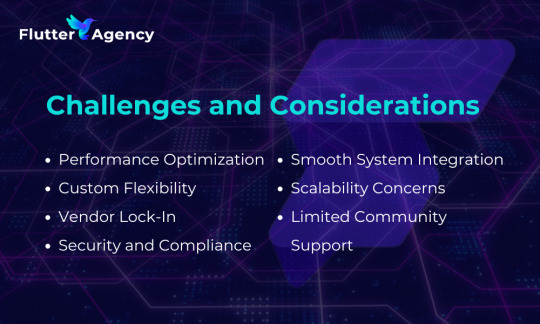
Although a robust low-code solution, several challenges startups ought to contemplate for effective app development are:
Performance Optimization:
While high productivity and ease of use are certainly low-code benefits, the trade-off is that it doesn't generally generate very optimized code, which can cause scalability problems in larger applications.
As a startup, you are likely to need some tweaks of the application performance, especially with huge data processing or very high traffic from users.
It Allows Customization and Flexibility
While Flutterflow does allow custom code injection, users may still be restricted in creating very specific or intricate functionality.
Some parts of the app will likely require more traditional coding in certain contexts, adding both time and complexity to development when compared with using nigiri.
Vendor Lock-In:
Using a particular low-code platform like Flutterflow in essence locks the team into it — resisting changing to another Limited options for flexibility or transitioning from one system to change have various operation and advancement costs.
Startups need to evaluate the scalability of FlutterFlow in the long run and prepare alternative solutions to avoid any single platform dependency.
Security and Compliance:
Some industries might not be comfortable with the level of security or compliance that comes with low-code platforms, for example, finance and healthcare.
Any startup in these verticals should put Flutterflow to the test and will likely also need to layer on some other security practices over time as they scale.
Seamless Integration with Your Systems
One challenge, in general though is to integrate Flutterflow apps with existing legacy or non-standard technologies.
Startups will need to have integration obstacles in mind and be prepared for them, which needs money to do.
Scalability Concerns:
As the startup matures, one may find themselves adding more dependencies as the features being built outpace what a low-code platform can provide.
This means start-ups must also be wary of how scalable Flutterflow is, and be ready to which over upon necessity to the tried and tested methods.
Limited Community Support:
Low-code platforms like Flutterflow will likely have smaller communities and fewer third-party resources than more established development frameworks.
This may present a challenge for startups, as they will struggle to avail supporting modules or get in touch with perfect-use products, and this is where detailed consideration of the development strategy being adopted by them should play an important role.
This Product Is A Little Easier For Non-Developers To Use – There is still some learning curve, but I guess that comes with the territory on almost all popup plugin options.
Flutterflow is built to make application designing easy and anyone can get the hang of it but a few things will be difficult for non-developers, especially those without experience in app development.
Ensuring team members have the training and resources they need to leverage the platform.
Startups can successfully ride the wild wave of low-code development with Flutterflow, provided that they approach these challenges thoughtfully and intentionally: before reaching a compromise between decisions best made without code or limitations on functionality plankton for mobile app success.
Conclusion
At Flutter Agency, we believe that low-code platforms are the building blocks for what may be the future of software development — a revolutionary process that will democratize app creation and speed applications to market. As the increasing need for quick innovation and value-based solutions rises, especially in mobile app development for startups, low-code tools such as Flutterflow are set to revolutionize how this industry operates.
With excellent integration with Flutter and comprehensive features, it seems to be one of the top platforms for connecting pro-developers and non-developers. The ideation stage for a unique custom-built application can be created so instantly, whereas the option of customization is available yet retains its flexibility as perceived necessary for specific business models.
Moving forward, as low code platforms take over like Flutterflow in the software development world. Some of how Flutterflow speeds up development time, reduces dependency on heavy coding skills, and improves team collaboration will help evolve how startups approach mobile app-building.
0 notes
Text
10 Best No Code App Development Platforms in 2024
With years of expertise blended with knowledge of the latest technologies, the experts at AppsRhino developed a no-code application development platform that is well-equipped to deliver solutions according to your needs. Be it for iOS, Android, Web, or cross-platform needs, AppsRhino ensures that their solution provides the finest experience to app users.
Flutterflow is another no-code app development platform, ideal for developing mobile apps that use Flutter as their technology. With the help of Flutterflow, it is now possible to build cross-platform apps with beautiful and intuitive UI within simple and clean code and deploy it in the app store quickly.
Glide specializes in building data-driven apps. Glide offers features such as in-app messaging, filters, user registration, and many more making itself one of our best no-code app development platforms.
The last on our list is Thunkable one of the best no-code app development platforms. With its unique drag-and-drop feature and wide range of components to choose from, Thunkable allows for creating stunning and functional mobile apps for its users without any prior coding experience.
The benefits of a no-code app development platform include faster app development, cost savings, accessibility for non-technical users, flexibility and customization options, and reduced maintenance. No-code app development allows individuals and businesses to create functional apps without extensive coding knowledge or hiring professional developers.
No, no-code app development is not going to replace developers. While no-code app development platforms offer a simpler way to create applications, there will always be a need for skilled developers to handle complex, custom, and highly specific development requirements.
0 notes
Text
FlutterFlow: The Right Platform to Embark Your Startup Journey
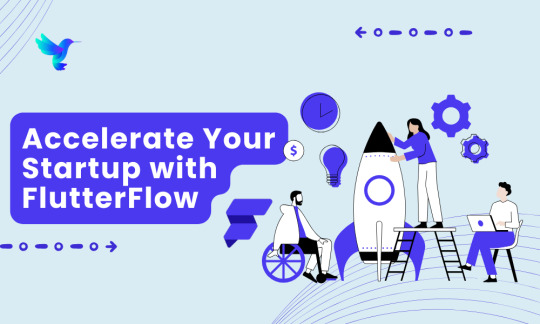
In the cut-throat competitive landscape of businesses, time to market, technology used, and profits generated are the cornerstones of defining success. The capability to implement advanced technology to innovate your business application and execute it successfully gives you a competitive edge. Traditional app development, with its daunting coding requirements and long timelines, often poses challenges for startups with an extended time to market.
Enters, low-code platforms that offer a simple solution to accelerate development without compromising on development quality. One of such platforms gaining popularity is, FlutterFlow.
Let’s explore why FlutterFlow is loved by so many startups and what it brings to the table. Before we get into the nitty-gritty of FlutterFlow, let’s dig in a little deeper to understand low-code development.
What Is Low Code Development?
Low code development refers to software development environments that let developers build applications through graphical user interfaces rather than traditional codes. The platforms reduce the amount of manual coding, which results in faster development lifecycles and easier iterations.
Benefits Of Low-Code Platforms
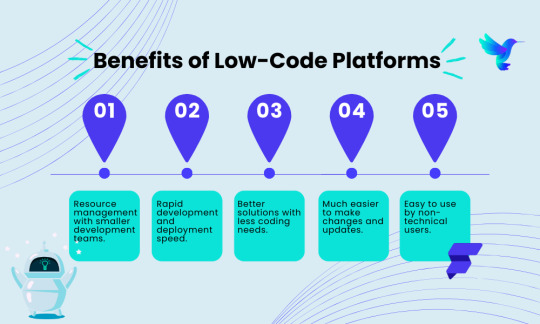
Rapid development and deployment speed.
Resource management with smaller development teams.
Better solutions with less coding needs
Easy to use by non-technical users, making it easier for them to contribute to the app development process.
Much easier to make changes and updates.
Thus with the ease and accessibility to even non-technical users, Low Code development is helping startups create professional applications on a budget. Some of the popular low-code platforms are Appian, Creatio, Outsystems, FlutterFlow, etc.
FlutterFlow gets a lead over others as it is taking low code development to new heights. Let’s now explore what makes FlutterFlow a perfect platform for your startup.
What is FlutterFlow?
FlutterFlow is built on Google’s Flutter framework, designed for developing cross-platform applications for Android, iOS, and the web. It offers a visual design interface, allowing users to plan app layouts effortlessly through simple drag-and-drop capability. FlutterFlow helps real-time collaboration, making it best for teams working together on a development project.
With an easy-to-use interface, no technical skills, and a strong framework to back it, FlutterFlow has been gaining popularity since it was conceived. Whether you are a startup or a small-scale business, if you want to create a mobile application that resonates with your audience, then, choose the FlutterFlow platform and let things flow.
Why FlutterFlow Is Perfect for Startups?
FlutterFlow is taking low code development to new heights by offering a visual development environment where users can build the solutions they want without compromising on app feature quality.
FlutterFlow basically incorporates and promotes best practices for software development. The platform streamlines complex IDE tasks into an intuitive UI, making developer interactions easier. To use the platform one needs basic training, thus even non-developers get into the basics of core app development concepts.
FlutterFlow entered the market with a vision to go from low code development to visual development. Here’s how the team is planning to achieve their goals:
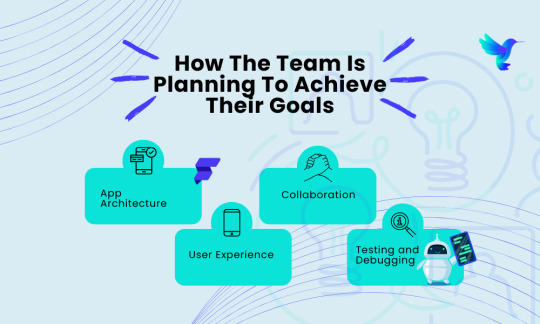
App Architecture: The codes generated using FlutterFlow meet the standards set by Flutter and Dart. They abide by the standard app market, thus helping users with a credible app development solution.
Testing and Debugging: The developers can simply test and debug the applications by running, testing, and resolving issues. This allows startups to enter the market with a flawless and highly rewarding application.
Collaboration: With modular development, smart version controls, and comprehensive access management, users can collaborate easily for better results.
User Experience: With an easy-to-explore interface, edit on clicks, ensure consistency, incorporate AI where possible, and users can switch between code and GUI.
FlutterFlow offers startups an environment where they can cross-operate, collaborate, and discuss their problems. The platform is conceived to make development easier, more convenient, and accessible for non-tech people also, who can easily make their contribution to the web now!
Some of the other advantages of the platform are:
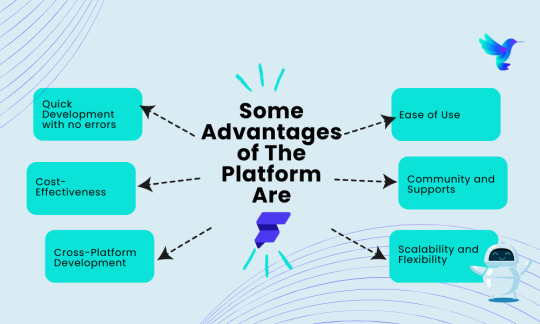
1. Quick Development With No Errors
The cheat code to making the best of your business is, to enter the market ASAP.
One of the most significant benefits of FlutterFlow is the speed at which the projects may develop. The platform’s visual interface and pre-built elements allow for speedy prototyping and development. Startups can fast-build minimum viable products (MVPs) to check thoughts in the marketplace without making a heavy investment in development sources.
Thus, you can create a product faster, take it to the market, and get feedback easily. We understand not every product works well on the first go, but with FlutterFlow you get the ease of making iterations and offering your audience a solution they’d appreciate.
2. Cost-Effectiveness
Most startups run on budget constraints. FlutterFlow helps reduce investing in large teams of seasoned developers. The platform’s drag-and-drop capability and pre-built templates lessen the quantity of custom code required, which translates to lower support and maintenance fees. A developer with lesser experience and understanding of the development languages can also, easily create an app here making it easier for you to invest your funds in other business verticals too.
3. Cross-Platform Development
FlutterFlow’s foundation lies at the Flutter framework which guarantees that applications are cross-platform by default. Thus by picking FlutterFlow startups can create and deploy applications to iOS, Android, and net platforms simultaneously. This cross-platform functionality is crucial for startups looking to maximize their target audience and digital presence without incurring the expenses and complexities of keeping separate codebases for specific platforms.
4. Ease Of Use
FlutterFlow is designed to be user-friendly, making it accessible to both skilled app developers and those with limited coding exposure. This democratization of app development means that non-technical founders and team members can contribute to the development procedure. FlutterFlow also gives tremendous documentation and tutorials, further decreasing the barrier to entry.
Because it is easy to use, the startup founders can make changes to the product as they want.
5. Scalability And Flexibility
Despite being a low-code platform, FlutterFlow gives massive flexibility. Users can add custom code to increase the functionality of their programs, making sure that they are now not confined with the aid of the platform’s built-in features. FlutterFlow additionally integrates seamlessly with backend services like Firebase and Supabase, bearing in mind robust and scalable backend solutions.
6. Community And Support
Being part of the Flutter ecosystem, FlutterFlow advantages from an active and supportive community. This network affords a wealth of assets, tutorials, and discussions that could assist startups conquer challenges and make the most of the platform. Additionally, FlutterFlow is continually evolving, with new capabilities and improvements being brought often based on user comments.
New users can always connect with the community for any assistance and customization thus creating a growth-oriented and learning ecosystem.
These are some of the most popular reasons why FlutterFlow is one of the most prominent low-code platforms for startups. So, if you are aiming to start your entrepreneurial journey and aren’t sure how to start without investing much in development, FlutterFlow is your trusted development partner.
Addressing Common Concerns of Using FlutterFlow
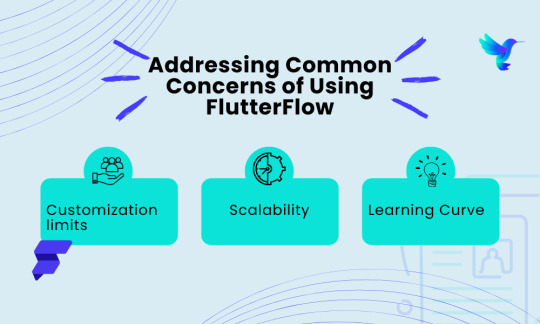
FlutterFlow may offer a great advantage for startups and businesses, but it does come with some limitations. Let’s explore the common concerns when working on the platform.
Customization Limits
The most common and often-faced concern with low-code platforms is the potential difficulty of customization. However, FlutterFlow mitigates this with the aid of custom code integration. This ensures that whilst you can enjoy the speed and efficiency of low-code development, you still have the flexibility to put into effect custom functions as wanted.
Scalability
Another concern is scalability. FlutterFlow is designed to handle significant user load and great data volumes through its integration with a powerful backend. Startups can hopefully scale their packages as their customer base expands, knowing that the platform is designed and developed to meet their business needs.
Startups with a limited user base can use the capabilities of FlutterFlow for future preparedness.
Learning Curve
While FlutterFlow is user-friendly, there can still be a strong learning curve, specifically for those new to app development. However, the considerable assets available, together with documentation, tutorials, and network help, assist mitigate this challenge.
Startups can always seek assistance from other development agencies experienced in FlutterFlow to boost learning and make sure first-class practices are followed. With little time and dedication, one can excel in their skills and implement them to build innovative products for the future.
Conclusion
FlutterFlow represents a tremendous advancement in the realm of low-code development systems, particularly for startups. Its combination of speed, value-effectiveness, ease of use, and flexibility makes it a super choice for early-stage businesses seeking to deliver their thoughts to the marketplace. By leveraging FlutterFlow, startups can reduce development time and fees, build cross-platform applications, and remain agile in a competitive landscape.
For startups and small-scale organizations trying to maximize their assets and boost their development process, FlutterFlow offers a compelling solution that bridges the gap between rapid prototyping and strong, scalable app development. As the platform continues to evolve and improve, it’s far poised to end up a good extra effective device for startups aiming to innovate and be triumphant in the virtual age.
#FlutterFlow#Custom App Development#FlutterFlow Startup businesses#Challenges for startups businesses#Low Code Development#graphical user interfaces#Benefits Of Low-Code Platforms#Google’s Flutter framework#cross-platform applications#Hire Flutter Developers#software development#advantage for startups and businesses
0 notes
Text
Become a Certified Flutter Developer with Edchart's Free Test
Unlock Your Potential with Edchart's Flutter Developer Certification Exam - Free Test
In the dynamic global of generation, staying ahead is paramount. Edchart, a worldwide chief in on line certification carriers, is devoted to empowering people by way of spotting their understanding thru online exams. Our partnership with CREDLY guarantees that your achievements are globally recounted and controlled with credibility. Explore our Flutter Certification offerings and take step one closer to unlocking your ability.

Advantages and Benefits of Edchart Certification
Recognition: Edchart Flutter App Developer certifications are diagnosed global, validating your knowledge and improving your professional credibility.
Career Advancement: With an Edchart Flutter Mobile App certification, you open doorways to new profession opportunities and advancement to your current function.
CREDLY Integration: Our partnership with CREDLY guarantees that your certifications are effortlessly shareable and verifiable, including fee in your professional profile.
Expert-Led Content: Our certification checks are designed by means of enterprise specialists, making sure relevance and comprehensiveness.
Flexibility: Take gain of our on line tests, Flutterflow Developers allowing you to have a look at and test at your personal pace and comfort.
Community Support: Flutter Firebase Join a thriving network of licensed professionals, networking and gaining knowledge of from like-minded individuals.
Scopes & Features of Edchart Certification
Edchart's Flutter Developer Certificationis designed to validate your skillability in Flutter, a famous framework for constructing move-platform programs. Our certification covers a huge variety of topics, together with:
Flutter Basics: Understand the fundamentals of Flutter framework, its architecture, and key principles.
Flutter Development Learn the way to broaden Flutter packages for cellular, internet, and desktop systems.
Firebase Integration: Explore Flutter Software to integrate Firebase services which include Firestore, Authentication, and Cloud Functions into your Flutter applications.
Flutter Testing: Master Flutter Application the artwork of checking out Flutter applications to make sure high-quality and reliability.
Performance Optimization: Discover techniques for optimizing Flutter applications for overall performance and efficiency.
Why Choose Edchart Certification?
Edchart Flutter Developer certification goes past just validating your talents; it empowers you to excel to your profession. Here's why you must select Edchart for your certification desires:
Quality Assurance: Our Flutter Dev certifications are meticulously designed and often updated to reflect the brand new enterprise tendencies and requirements.
Global Recognition: Edchart Flutter Flow certifications are respected international, establishing doorways to international profession possibilities.
Credibility: With our partnership with CREDLY, your certifications are backed by way of a relied on platform, making sure credibility and authenticity.
Flexibility: Study Flutter App and take a look at at your very own pace, with out compromising on your other commitments.
Community: Join a vibrant community of certified experts, where you may community, proportion information, and develop collectively.
Who Will Benefit from Edchart Certification?
Edchart certifications are ideal for:
Flutter Framework: Individuals trying to kickstart their profession in Flutter improvement.
Experienced Developers: Professionals looking for to validate their talents and advance their profession potentialities.
Entrepreneurs: Business proprietors and marketers seeking to construct their very own Flutter Web packages or lead development teams.
Students: Students interested in learning Flutter and improving their employability inside the tech enterprise.
Unlock your capacity with Edchart's Flutter Developer Certification. Take the free take a look at these days and embark on a journey towards achievement. Click here to get commenced.

Become a Certified Flutter Developer with Edchart's Free Test
Unlock Your Potential with Flutter Certification
Flutter Developer Certification from Edchart is recognized as the gold fashionable in validating understanding in Flutter Developer improvement. With our free check, you can kickstart your journey closer to turning into an authorized Flutter Developer . Take the check now and be part of the ranks of elite Flutter Developer s international.
Advantages and Benefits of Flutter Developer Certification
Industry Recognition: A Flutter Certification from Edchart is quite respected in the industry, showcasing your skillability in Flutter Development.
Career Advancement: Certification opens doorways to new profession possibilities and better-paying roles inside the tech enterprise.
Validation of Skills: By incomes certification, you validate your competencies and knowledge in growing sturdy Flutter Applications.
CREDLY Integration: Our partnership with CREDLY ensures that your certification is effortlessly shareable and verifiable, adding credibility for your professional profile.
Access to Resources: Certified builders benefit access to unique resources, networks, and task opportunities.
Continuous Learning: Edchart certifications inspire non-stop studying and skill development to live updated with the latest traits and technology in Flutter Development.
Scopes & Features for Flutter App Certification
Comprehensive Curriculum: Our Flutter App Certification covers all components of Flutter Development, such as fundamentals, superior functions, and satisfactory practices.
Hands-on Projects: Gain practical revel in thru hands-on initiatives and real-global eventualities to reinforce your competencies.
Expert-Led Content: Learn from industry experts who layout and curate the certification content to make sure relevance and comprehensiveness.
Interactive Learning: Engage in interactive learning reviews, quizzes, and exams to boost your knowledge of Flutter Development standards.
Flexibility: Study and put together for certification at your very own pace, with get right of entry to to on line resources and guide.
Exam Preparation: Get get entry to to exam coaching substances, practice exams, and mock assessments to enhance your self assurance before taking the certification examination.
Why Take Flutter Web Certification?
Flutter Web offers numerous advantages:
Cross-Platform Development: With Flutter Developer, you may construct internet programs that run seamlessly across distinctive structures, which include computer and mobile.
Single Codebase: Develop net programs with a unmarried codebase, decreasing improvement time and effort.
High Performance: Flutter Certification performance-optimized structure guarantees rapid and responsive net packages.
Rich User Interfaces: Create visually lovely and interactive consumer interfaces for net applications the usage of Flutter Application rich set of widgets and libraries.
Growing Demand: The call for for Flutter Web builders is at the upward push, making certification a treasured asset for career advancement.
Who Will Benefit from Flutter Software Certification?
Flutter Software Certification is good for:
Software Developers: Professionals seeking to decorate their skills and expertise in Flutter Development.
Web Developers: Individuals inquisitive about expanding their talent set to consist of Flutter Software for constructing net packages.
Mobile App Developers: Developers looking to leverage Flutter Mobile App for growing move-platform mobile packages.
Entrepreneurs: Business owners and marketers interested in constructing their personal Flutter App Developer -primarily based software program solutions.
Students: Students pursuing careers in software development and trying to focus on Flutter Programming generation.
Unlock your potential and end up a certified Flutter Developer with Edchart. Take the loose check now and embark on a rewarding career journey in Flutter Development.
0 notes
Text
FLUTTERFLOW: EVERYTHING YOU NEED TO KNOW
You're likely already familiar with Flutter, Google's incredibly useful UI toolkit that has made creating apps much simpler. In fact, since May 2021, when FlutterFlow, a drag-and-drop interface created by two former Google developers, was released, things have gotten even simpler. FlutterFlow makes it easy to create mobile apps for both iOS and Android.
In this article, we'll cover everything you need to know about FlutterFlow, including its precise definition, attributes, advantages, and cost. But first, a brief introduction to our beloved Flutter, to give you some perspective.
What is Flutter?
Google Flutter is a "UI toolkit for building beautiful, natively-compiled applications for mobile, web, and desktop from a single codebase," according to the company's website. As a full SDK, it offers users all the tools they need to build cross-platform applications, including pre-made widgets, a rendering engine, and testing and integration APIs.
Google Flutter is free and open-source, integrates with existing code, and is utilized by developers and businesses all over the world. eBay, the Alibaba Group, and BMW are just a few of the development firms presently utilizing Flutter. As a result, among software engineers, it is one of the top preferred skills. When developing Google Ads and smart displays like the Google Home Hub, Google employed the Flutter framework.
What is Flutter Flow
Two former Google developers launched FlutterFlow to serve as a third-party visual app builder for the Flutter platform. It was showcased at Google I/O and is supported by Y Combinator.
As we've already mentioned, FlutterFlow is a drag-and-drop mobile app development tool that runs in the browser. This implies that you don't need to write any code in order to design amazing custom apps in less than an hour. Consider it the Wix or GoDaddy of mobile application development company.
The 2.0 version of the interface, which was introduced at the start of October, is already available. Without giving away its features, there isn't much else we can say, so let's get started!
Features
Build an application without writing any code
Although it may seem rather clear, this is unquestionably the most alluring thing FlutterFlow has to offer.
the creation of both iOS and Android
You can make an app without writing any code, and you can do it simultaneously for iOS and Android.
UI components and templates
You may choose from more than 40 pre-built widgets, over 50 screen designs, and various third-party connectors (like Braintree and Google AdMob) that will save you a tonne of time.
Create your app and add live data to it.
You may easily set up data infrastructure and connect to real-time data using Firebase.
Authentication of users
By integrating Firebase, Google, and Facebook logins, user authentication can be completed very quickly by simply dragging a button.
Configuration of GitHub
With GitHub integration, you may connect your project to a GitHub repository and push the code there whenever you wish.
Obtain the source code
The clean and simple-to-read source code for your mobile app is available for easy download, so you are solely responsible for it.
help with troubleshooting
Through real-time feedback and error correction, any difficulties can be readily avoided and fixed.
Last words on FlutterFlow
FlutterFlow appears to be a wise choice for projects with constrained resources and time constraints. We hope you've learned everything there is to know about FlutterFlow from this article. How do you feel? Ready to give it a try?
The most reputable and well-known Flutter app development company in USA. Wama Technology skilled Flutter mobile app developers make sure that the entire development process is effective and adheres to the exact customer requirements. Our development staff is well-versed in the most up-to-date Flutter app development technologies and techniques. We offer complete Flutter app development services for Android and iOS, including the prototype, UI/UX design, programming, and deployment. To learn more about your Flutter app development project, get in touch with a specialist right away.
0 notes
Text
How to Create a Desktop Window Application in Flutter?
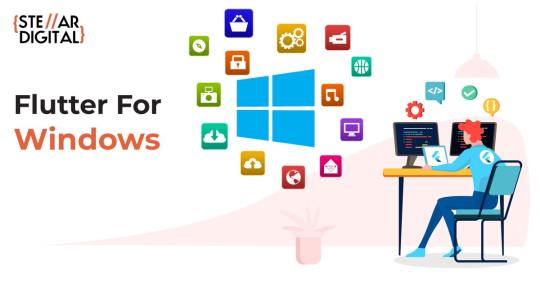
WHAT IS FLUTTER?
When Objective C/Swift and Java/Kotlin were the two most popular mobile development languages, creating apps was costly. You had to complete the task twice since you had to make two distinct apps. To solve this problem, a number of frameworks for creating hybrid (or cross-platform) apps in JavaScript and HTML5 have been created. Among cross-platform toolkits such as PhoneGap, Xamarin, React Native, and others, the Flutter framework has fast garnered popularity among developers, enterprises, entrepreneurs, and users.
With the help of the portable UI toolkit Flutter, you can produce native-looking apps for desktop, mobile, and the web with a single codebase. It makes use of Cupertino widgets, Material Design, and the Dart programming language. Flutter programmers can design beautiful user interfaces that feel and look native. Despite employing a single codebase, it functions normally across all platforms.
WHY FLUTTER AND WINDOWS?
A bold plan to spread Flutter beyond iOS and Android mobile apps to additional platforms including the web and desktop was outlined a couple of years ago.
Desktop applications aren't just mobile applications with a bigger screen. They are designed to work with a variety of input methods, including a keyboard and mouse. They typically appear on a widescreen monitor and have resizable windows. Important concepts like accessibility, input method editors, and visual styling all have their own conventions. Desktop apps support anything from file system selections to device hardware to data stores like the Windows registry, in addition to interacting with numerous APIs in the underlying operating system.
So, while we've been introduced to Flutter for Windows, we've also noticed that it's designed for Windows.
The Windows team was approached and asked to say a few words about Flutter's support. According to Kevin Gallo, Microsoft's Corporate Vice President of Windows Developer Platform:
“We’re delighted to see Flutter adding support for creating Windows apps. Windows is an open platform, and we welcome all developers. We’re excited to see Flutter developers bring their experiences to Windows and also publish to the Microsoft Store. Flutter support for Windows is a big step for the community, and we can’t wait to see what you’ll bring to Windows!”
TOOLS FOR FLUTTER TO DEVELOP WINDOWS APP
To enable seamless integration, Google's tooling partners have started including support for Windows in the updated Flutter. It's incredibly encouraging to see how Flutter has developed into a mature ecosystem, and if you want to use Flutter to build Windows apps, you should have a look at each of these tooling partners. Here are a few examples:
FlutterFlow:
It is a low-code application development tool for Flutter. With FlutterFlow's features, developers can now create Windows apps that are optimised for desktop use.
Codemagic:
This CI/CD solution has been improved by Never Code to support creating, testing, and automatically releasing Windows apps to the Microsoft Store while also enabling cloud-based development.
Realm:
You may now create desktop apps for Windows using the most recent version of this Flutter utility. With the aid of Dart FFI, it's a blazing-fast local data storage that offers quick access to the main database.
Apart from these there are other tools as well.
CONCLUSION
Flutter 2.10 includes stable, production-quality support for building Windows apps, as well as a slew of other features, performance enhancements and bug fixes that shall be detailed in the future.
We, at Stellar Digital are a renowned Flutter app development company that can assist your business with providing excellent applications and websites built via Flutter. Our Flutter developers are quite experienced in their domain and would definitely understand your business requirements.
Contact Stellar Digital right away to discuss the possibility and benefits of using Flutter app development for your project!
0 notes
Text
Flutterflow App Development: Streamlining Mobile App CreationFlutterflow App Development: Streamlining Mobile App Creation
Want to create a beautiful and functional app? Look no further than Our expert team specializes in Flutterflow app development, bringing your ideas to life with stunning designs and seamless functionality. Contact us today to start building your dream app!
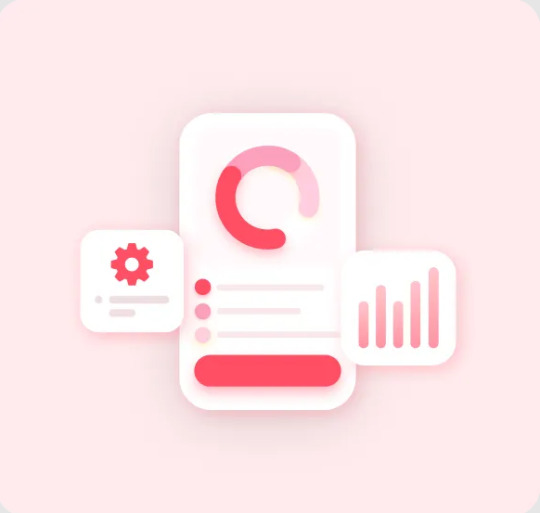
Flutterflow is revolutionizing the way mobile apps are developed by providing a no-code platform that bridges the gap between design and development. For entrepreneurs, small businesses, and developers, it offers a simplified yet powerful solution to build fully functional apps without extensive coding knowledge.
What is Flutterflow?
Flutterflow App Development is a visual development platform built on top of Google’s Flutter framework. It allows users to design, prototype, and export Flutter code seamlessly. The tool enables non-technical users and developers alike to create mobile applications with minimal effort, saving time and resources.
Key Features of Flutterflow
Drag-and-Drop Interface: The visual interface allows users to drag and drop components like buttons, images, and text fields, making it easier to build and customize app layouts.
Customizable Widgets: Flutterflow includes pre-built Flutter widgets which can be easily customized, giving developers full control over the app's appearance and functionality.
Backend Integration: The platform supports backend services, allowing users to integrate Firebase, Firestore, and REST APIs. This makes managing databases, authentication, and other backend processes straightforward.
Real-Time Collaboration: Flutterflow supports multi-user collaboration, making it possible for teams to work together in real time on the same project, boosting productivity and communication.
Auto-generated Code: Once you design your app, Flutterflow auto-generates clean Flutter code, which can be exported, modified, or deployed directly to Android and iOS stores.
Animations and Actions: Adding animations and interactive actions is intuitive, letting users create engaging user experiences without manually coding transitions or effects.
Benefits of Using Flutterflow
Faster Development: Since the tool auto-generates code from designs, development time is significantly reduced. There’s no need to switch between design and development tools, saving hours of manual work.
Low Technical Barrier: Entrepreneurs and designers with limited coding experience can build complex apps, while developers can focus more on custom functionality.
Cost Efficiency: The reduced development time and requirement for fewer technical skills make Flutterflow an economical choice for startups and businesses.
Flexibility: The platform provides flexibility for both beginner and advanced users, from visually creating simple apps to integrating advanced functionalities.
Challenges and Limitations
While Flutterflow Developer is a robust platform, it has its limitations:
Learning Curve: For those unfamiliar with Flutter or Firebase, there might be an initial learning curve when navigating backend integrations or more complex features.
Customization Boundaries: Although it generates Flutter code, users looking for highly customized logic or features may still need to tweak the code manually outside the platform.
Flutterflow stands out as a game-changing tool in the no-code app development space. By empowering users to design and deploy mobile applications without in-depth programming knowledge, it opens the doors to faster, more efficient, and cost-effective app development. Whether you're a solo entrepreneur or part of a development team, Flutterflow simplifies the mobile app creation process without compromising quality or functionality.
For more info. Visit us:
Top Flutterflow Development Company
Flutterflow App Development Agency
Hire Flutterflow App Developer
0 notes
Text
Why FlutterFlow is the Ultimate Tool for Rapid MVP Development
In the fast-paced world of app development, speed is everything. Startups and entrepreneurs are constantly looking for ways to turn their ideas into tangible products quickly. That's where Develop Mvp In Flutterflow comes in. This innovative platform allows you to develop MVPs (Minimum Viable Products) faster than ever before, giving you a competitive edge in today's market. Imagine being able to visualize your app concept without writing extensive lines of code. With FlutterFlow, that dream becomes a reality. It's not just about getting something out there; it's about creating a polished prototype that can attract investors and gather user feedback efficiently. Whether you're an experienced developer or just starting on your journey, FlutterFlow offers tools that simplify the entire process of developing an MVP. Let's dive deeper into why this tool stands out and how you can harness its power for your next big idea!
Benefits of Using FlutterFlow for Rapid MVP Development
FlutterFlow streamlines the MVP development process, making it accessible for everyone. Its drag-and-drop interface allows users to design interfaces intuitively, eliminating the need for extensive coding skills. Collaboration is another significant advantage. Team members can easily share projects in real time, enabling seamless feedback and iteration. This fosters an environment where ideas can flourish without delays. Speed is vital when launching a product. FlutterFlow accelerates app creation by providing pre-built components that you can customize to fit your needs. You no longer have to start from scratch. Moreover, its integration with Firebase simplifies backend management. This means you can focus on building exciting features rather than dealing with complex server setups or data management issues. With FlutterFlow's cross-platform capabilities, your MVP can run smoothly on both iOS and Android devices. This ensures broader reach and quicker user testing right from the start.
Step-by-Step Guide to Using FlutterFlow for Rapid MVP Development
Getting started with FlutterFlow is straightforward. First, create an account on the platform. This gives you access to a user-friendly interface designed for developers and non-developers alike. Once logged in, choose your project type. You can select from various templates tailored for different app categories. This helps streamline your design process significantly. Next, dive into the drag-and-drop editor. Here, you can customize layouts easily by adding widgets like buttons and forms without writing extensive code. After that, connect any necessary databases or APIs. FlutterFlow allows seamless integrations, which means you can focus more on functionality rather than heavy backend work. Test your MVP directly within FlutterFlow’s environment. This built-in feature enables quick adjustments before deployment across platforms—whether iOS or Android—ensuring that you're always ahead of potential issues while maintaining efficiency.
Tips and Tricks for Maximizing the Potential of FlutterFlow
To truly harness the power of FlutterFlow for your MVP development, consider these essential tips and tricks. First, familiarize yourself with the platform's extensive library of pre-built components. These elements can significantly speed up your design process. Instead of starting from scratch, leverage what’s already available to create a polished user interface quickly. Next, take advantage of FlutterFlow's visual editor. This feature allows you to see real-time changes as you build. It not only helps in maintaining consistency but also makes it easier to identify what works best for your users without extensive coding knowledge. Integrate third-party APIs effortlessly within FlutterFlow. Doing so will enrich your app’s functionality while keeping your workload manageable. Explore various integrations that fit well with your project requirements; they can elevate the user experience dramatically. For More Ibnformation:
Flutterflow Web App
Flutterflow Web Development Agency
Flutterflow App Development Agency
0 notes
Text
Enterprise Flutterflow Training with Flutterflowdevs

In today’s competitive business landscape, staying ahead in the tech-driven world requires embracing innovative tools and technologies. FlutterFlow, a powerful no-code platform, has emerged as a game-changer for businesses looking to accelerate their app development processes. With its intuitive drag-and-drop interface and robust features, FlutterFlow empowers enterprises to build sophisticated applications without extensive coding. However, mastering this platform requires expert guidance and a comprehensive approach. That’s where Flutterflowdevs’ Enterprise Flutterflow Training comes in, providing tailored solutions to meet your organization’s unique needs.
Why Choose Enterprise Flutterflow Training?
For organizations aiming to streamline their app development workflow and reduce time-to-market, investing in structured training is essential. Enterprise Flutterflow Training by Flutterflowdevs equips teams with the skills and knowledge they need to maximize the potential of the FlutterFlow platform. Here are some key benefits:
Customized Learning Paths: Every business is unique, and so are its application requirements. Flutterflowdevs’ training programs are designed to address your organization’s specific goals and challenges, ensuring your team acquires the right skills to deliver impactful solutions.
Expert Guidance: Led by industry experts with extensive experience in app development and FlutterFlow, our training sessions provide insights and best practices that are hard to find elsewhere. From beginner-level fundamentals to advanced techniques, your team will be guided every step of the way.
Hands-on Experience: Learning by doing is the cornerstone of effective training. Flutterflowdevs emphasizes practical, hands-on exercises that allow participants to work on real-world projects and scenarios. This approach not only enhances understanding but also boosts confidence in using FlutterFlow for enterprise-level applications.
Increased Efficiency: By mastering FlutterFlow, your team can significantly reduce development time and costs. This efficiency enables your business to allocate resources strategically and focus on innovation rather than being bogged down by lengthy coding processes.
Scalability and Collaboration: Enterprise Flutterflow Training prepares your team to build scalable applications that grow with your business. Additionally, the training promotes collaboration, ensuring your developers, designers, and product managers are aligned and work seamlessly together.
What to Expect from Flutterflowdevs’ Enterprise Training Program
Flutterflowdevs’ Enterprise Flutterflow Training is structured to provide a holistic learning experience. Here’s what you can expect:
Foundational Understanding
The training begins with an overview of FlutterFlow, its features, and its capabilities. Participants learn how to navigate the platform, understand its core functionalities, and explore how it integrates with other tools and technologies.
Advanced Techniques and Features
As the training progresses, your team will dive into advanced topics such as:
Customizing widgets and components
Managing complex workflows and data models
Integrating APIs and external services
Implementing authentication and security protocols
Optimizing performance for enterprise-scale applications
Collaborative Workshops
Interactive workshops are a highlight of the training program. Teams collaborate to solve challenges, build prototypes, and refine their projects under the guidance of Flutterflowdevs’ experts.
Post-Training Support
Flutterflowdevs doesn’t stop at training delivery. We provide ongoing support to ensure your team continues to thrive. Whether it’s troubleshooting, answering questions, or offering additional resources, our team is committed to your success.
For more details, you can visit us:
Flutterflow Web App
Flutterflow Web Development Agency
Top Flutterflow Development Company
0 notes
Text
Transforming Ideas into Stunning Digital Experiences with FlutterflowDevs

In today’s fast-paced digital world, businesses need more than just an online presence—they need a seamless, engaging, and user-friendly experience. Whether you are a startup looking to establish your brand or a well-established company seeking to elevate your digital platform, FlutterflowDevs stands out as a top-tier agency dedicated to delivering exceptional digital solutions. Specializing in FlutterFlow, a powerful no-code platform for building beautiful apps, FlutterflowDevs helps businesses unlock the potential of high-quality digital products without the complexity and cost of traditional app development.
What is FlutterFlow?
Flutterflow Agency is a game-changing tool in the world of app development, providing a no-code environment for creating visually stunning mobile and web applications. This platform combines the ease of drag-and-drop design with the power of Flutter, Google's open-source UI toolkit, to create apps that are both fast and scalable. FlutterFlow is designed for developers and non-developers alike, allowing teams to prototype, design, and launch applications faster and more efficiently.
At FlutterflowDevs, the team harnesses the capabilities of FlutterFlow to create responsive and beautiful apps that drive business growth. From eCommerce platforms to social networking apps, FlutterFlow's versatility makes it the go-to solution for businesses looking to create an app that aligns perfectly with their vision.
Why Choose FlutterflowDevs?
Expertise in FlutterFlow Development FlutterflowDevs prides itself on being an expert in FlutterFlow development. With a team of experienced designers and developers, the agency excels in harnessing the platform’s capabilities to build fully customized applications. Whether you need a simple app or a complex, feature-rich platform, FlutterflowDevs can transform your ideas into a reality with precision and professionalism.
Speed and Efficiency One of the greatest advantages of using FlutterFlow is speed. FlutterFlow enables rapid prototyping and development, reducing the time it takes to build an application significantly. At FlutterflowDevs, the team takes full advantage of this, ensuring that your project is delivered on time and within budget. Whether you're looking for a prototype or a fully functional app, FlutterflowDevs ensures a quick turnaround while maintaining high-quality standards.
Cost-Effective Solutions Traditional app development can be expensive, especially for small businesses and startups. FlutterFlow’s no-code approach significantly reduces the development costs. By using FlutterFlow, FlutterflowDevs delivers cost-effective solutions that don’t compromise on quality. You get a robust, scalable app at a fraction of the cost of conventional development methods.
Seamless User Experience FlutterFlow is known for creating visually stunning user interfaces, and FlutterflowDevs takes this to the next level by designing apps that are not only beautiful but also highly functional. By focusing on user experience (UX) design, the agency ensures that every app it creates provides a seamless and engaging experience. From intuitive navigation to smooth animations, FlutterflowDevs crafts apps that captivate users and keep them coming back for more.
Scalability and Flexibility FlutterFlow's foundation is built on Flutter, which is known for its scalability and flexibility. As your business grows, your app needs to evolve as well. With FlutterFlow and FlutterflowDevs' expertise, your app will be able to scale effortlessly, adapting to new features, functionalities, and user demands. The agency ensures that every app is designed with future growth in mind, providing you with a sustainable digital solution for the long term.
Services Offered by FlutterflowDevs
Custom App Development Whether you’re building an app from scratch or need custom features added to an existing one, FlutterflowDevs offers tailored development solutions that align with your business goals.
App Design and Prototyping The agency specializes in creating sleek, modern designs that reflect your brand’s identity. With the help of FlutterFlow’s design tools, the team can create prototypes that offer a glimpse into the future of your app before it's fully developed.
App Maintenance and Updates FlutterflowDevs offers ongoing maintenance services to ensure that your app remains up to date, secure, and fully functional as new updates and features are released.
App Consulting If you’re unsure about how to bring your app idea to life or whether FlutterFlow is the right solution for your needs, FlutterflowDevs offers expert consulting to guide you through the process.
For more details, you can vist us:
Flutterflow Development Company
Flutterflow Development Agency
Enterprise Flutterflow Training
0 notes
Text
Why Flutterflowdevs is the Leading FlutterFlow Agency for Your App Development Needs
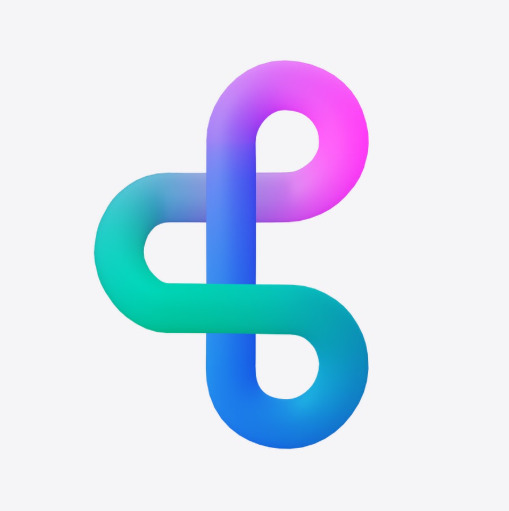
In today’s fast-paced digital world, mobile apps have become essential for businesses to engage with their customers, streamline operations, and provide a seamless user experience. For businesses looking to create sophisticated, high-performance apps without the traditional development time and cost, FlutterFlow has emerged as one of the most popular no-code development platforms. For those seeking expert guidance and custom solutions built using FlutterFlow, Flutterflowdevs is the agency that stands out.
What Makes Flutterflowdevs the Best FlutterFlow Agency?
FlutterFlow is a powerful platform that allows businesses to build mobile applications quickly using a visual interface, all without writing extensive lines of code. It leverages the capabilities of Flutter, Google’s UI toolkit, to help developers design and deploy native apps for iOS, Android, and web platforms from a single codebase. However, while FlutterFlow offers a user-friendly platform, creating a successful, feature-rich app still requires deep expertise and skill. That's where Flutterflowdevs comes in.
Flutterflowdevs is a leading FlutterFlow agency specializing in providing comprehensive app development services. Their team of experienced professionals is well-versed in FlutterFlow's intricacies, ensuring that clients receive high-quality, fully customized apps tailored to their unique needs. Whether you’re looking to build a mobile app from scratch or enhance an existing one, Flutterflowdevs offers a range of services that help you bring your vision to life quickly and effectively.
Expertise in No-Code Development
One of the biggest advantages of FlutterFlow is its no-code approach, which allows businesses to quickly prototype and launch apps without requiring deep coding knowledge. However, building a truly robust, scalable, and visually appealing app still requires technical expertise. Flutterflowdevs excels in turning these no-code tools into powerful, fully functional mobile apps. Their team uses the full potential of FlutterFlow to craft unique, high-performance applications that meet your specific business objectives.
From advanced workflows and animations to integrating APIs and databases, Flutterflowdevs ensures that the app is more than just a simple drag-and-drop project. They bring their extensive experience in app development to deliver applications that are not only functional but also intuitive and user-friendly.
Fast and Cost-Effective Development
For businesses, time and cost are critical factors in app development. Traditional app development can be expensive and time-consuming, often requiring lengthy coding phases and iterative testing. With FlutterFlow, app development becomes significantly faster, allowing businesses to prototype and launch their apps in a fraction of the time compared to conventional methods.
Flutterflowdevs leverages this speed to provide a more cost-effective development process. By using FlutterFlow, they can quickly create high-quality apps at a fraction of the price of traditional development, making it an ideal choice for startups, small businesses, and enterprises looking to reduce overhead costs while still delivering top-tier apps.
Tailored Solutions and Seamless Integration
Every business has different needs, and a one-size-fits-all approach doesn’t work for mobile app development. Flutterflowdevs understands this and offers fully customized solutions designed to align with your business goals. Whether you need a simple app to showcase your products or a complex platform with integrated services, Flutterflowdevs has the experience to deliver.
In addition, their team can seamlessly integrate third-party tools and services, such as payment gateways, user authentication, real-time databases, and analytics, to provide a complete app ecosystem that supports your business operations.
Why Choose Flutterflowdevs?
Choosing Flutterflowdevs for your FlutterFlow app development means working with a trusted agency that prioritizes your success. Their commitment to delivering high-quality, fully functional apps is matched only by their dedication to excellent customer service. From the initial consultation to post-launch support, Flutterflowdevs is with you every step of the way to ensure your app meets your expectations.
Their team stays updated with the latest FlutterFlow features and industry trends, ensuring that your app remains competitive and cutting-edge. With a track record of successful projects across various industries, Flutterflowdevs has built a reputation for excellence and reliability.
For more details, you can visit us:
Flutterflow Development Company
Flutterflow Development Agency
Enterprise Flutterflow Training
0 notes
Text
Flutterflow Expert: Why Flutterflowdevs is the Leading Choice for Your App Development Needs

In today’s fast-evolving tech world, mobile and web applications are at the heart of business success. As the demand for faster, more cost-effective solutions increases, businesses are turning to no-code and low-code platforms to bring their ideas to life. One of the most innovative platforms to emerge in recent years is FlutterFlow, an intuitive, drag-and-drop tool built on Google’s Flutter framework. FlutterFlow allows developers and non-developers alike to create powerful applications with minimal coding required. But to truly unlock the potential of FlutterFlow and build a top-tier application, you need the expertise of a FlutterFlow expert.
Why You Need a FlutterFlow Expert
While FlutterFlow simplifies the app development process, it still requires specialized knowledge to take full advantage of the platform’s capabilities. A FlutterFlow expert is someone who deeply understands the platform, its limitations, and its potential. Without the right expertise, it's easy to make missteps that could affect your app’s performance, design, or scalability.
A FlutterFlow expert can help you:
Design seamless, user-friendly interfaces.
Integrate advanced functionalities like authentication, APIs, and real-time data.
Optimize app performance across platforms (iOS, Android, Web).
Ensure that your app is scalable and future-proof.
Troubleshoot and resolve issues efficiently.
With a FlutterFlow expert like Flutterflowdevs, you can be confident that your project is in the hands of professionals who understand the intricacies of the platform.
Why Choose Flutterflowdevs as Your FlutterFlow Expert?
Flutterflowdevs is a recognized leader in FlutterFlow development, known for its team of skilled experts who can handle every aspect of your app development needs. Whether you need a basic app for a small business or a complex enterprise-level solution, Flutterflowdevs has the knowledge and experience to deliver.
1. In-Depth Knowledge of FlutterFlow
FlutterFlow is a powerful tool that offers both no-code and low-code development capabilities, but mastering it requires an expert understanding of its components. Flutterflowdevs’ team consists of experienced developers who have extensive knowledge of FlutterFlow’s features, such as visual app design, integrations with APIs and databases, Firebase support, and custom code solutions. Their deep understanding of FlutterFlow ensures that every project is executed with precision and expertise.
3. Efficient Development Process
The biggest advantage of using FlutterFlow is its ability to significantly speed up the development process, allowing you to launch your app faster. Flutterflowdevs harnesses the power of FlutterFlow’s drag-and-drop interface, pre-built widgets, and seamless Firebase integration to develop apps in record time. This speed doesn’t come at the cost of quality, as their experts ensure that every app is optimized for performance, user experience, and scalability.
4. Cost-Effective Development
One of the primary benefits of using FlutterFlow is that it drastically reduces development time and costs compared to traditional coding methods. Flutterflowdevs passes on these savings to you by offering affordable pricing without compromising on the quality of the end product. Whether you're a startup with a limited budget or a larger company looking to optimize your app development process, Flutterflowdevs provides cost-effective solutions that deliver real value.
5. Seamless Cross-Platform Development
FlutterFlow allows for the creation of cross-platform applications, meaning that a single codebase can be deployed on iOS, Android, and the web. Flutterflowdevs ensures that your app provides a consistent, responsive experience across all platforms. Their team expertly designs and develops apps that perform smoothly on various devices, ensuring that users enjoy a seamless experience no matter where they access your app.
6. Post-Launch Support and Maintenance
The journey doesn’t end once your app is live. With Flutterflowdevs, you get continued support and maintenance to ensure your app remains updated and fully functional. Whether you need to add new features, fix bugs, or improve app performance, their experts are available to assist you with ongoing updates and troubleshooting.
For more details, you can visit us:
Enterprise Flutterflow Training
Develop Mvp In Flutterflow
Flutterflow Development Company
0 notes
Text
Streamlining Success: A Deep Dive into Flutterflow for Web Development Agencies

In today’s fast-paced digital landscape, web development agencies face an increasing demand for rapid and efficient solutions. Clients expect stunning websites that not only look great but also offer seamless user experiences. As competition heats up, the need for streamlined processes becomes more critical than ever. Enter Flutterflow—an innovative platform designed to revolutionize how we approach web development. This powerful tool combines intuitive design capabilities with robust functionality, making it a game changer for developers and designers alike. If you’re part of a Flutterflow web development agency or considering using this platform, prepare to discover how it can elevate your projects to new heights while saving time and resources. Let’s explore what makes Flutterflow such an essential asset in modern web development strategies.
Understanding the Need for Streamlined Web Development
Web development is evolving at a breakneck speed. Clients are increasingly impatient, expecting quick turnarounds without compromising quality. This pressure requires agencies to adopt more efficient workflows. Streamlined web development isn’t just about faster delivery; it's also about enhancing collaboration among teams. When designers and developers can work seamlessly together, creativity flourishes. Silos between departments often lead to miscommunication and delays. Moreover, as user expectations rise, maintaining high standards becomes essential. A streamlined process helps ensure that every project achieves the desired functionality while being visually appealing. Agencies must stay competitive by embracing tools that simplify complex tasks. An agile approach allows for quicker adjustments based on client feedback or market trends, ensuring relevance in an ever-changing landscape. In this environment, efficiency isn't merely advantageous—it's vital for survival and growth in the industry.
Introducing Flutterflow: An Overview of the Platform
Flutterflow is an innovative platform revolutionizing web development. It combines the power of Flutter with a user-friendly interface, making app creation accessible to developers and designers alike. With its drag-and-drop functionality, building beautiful, responsive applications becomes a breeze. You don’t need extensive coding knowledge to get started. This democratizes design and empowers teams to turn ideas into reality faster. Collaboration is at the heart of Flutterflow. Teams can work simultaneously on projects without stepping on each other's toes. The real-time updates keep everyone in sync, enhancing productivity. Moreover, integrating APIs and managing databases is simpler than ever. Developers can focus more on creativity rather than getting bogged down by technical complexities. This makes Flutterflow an ideal choice for web development agencies looking to streamline their processes while maintaining high-quality output.
Streamlining the Design Process with Flutterflow
Flutterflow transforms the design process for web development agencies. Its intuitive interface allows designers to create stunning, responsive layouts without extensive coding knowledge. With a drag-and-drop functionality, users can quickly prototype ideas. This accelerates the design phase and encourages creative experimentation. Collaborators can see real-time updates, making adjustments seamless and efficient. The platform also offers pre-built components that save time on common design elements. Agencies can focus on unique features rather than reinventing the wheel with every project. Integrated testing tools ensure designs work across various platforms from the start. This eliminates last-minute surprises during deployment and enhances user experience. By streamlining these processes, Flutterflow helps agencies deliver projects faster while maintaining quality standards. The result is a more agile team ready to take on new challenges in a competitive market.
Collaborative Features for Efficient Teamwork
Flutterflow shines when it comes to enhancing collaboration within web development teams. The platform is designed with teamwork in mind, allowing multiple users to work on a project simultaneously. This simultaneous editing feature eliminates the bottlenecks often associated with traditional development methods. Team members can easily share feedback and make modifications in real-time. Integrated communication tools allow for seamless discussions without needing separate messaging platforms. This fosters an environment where creativity thrives as everyone contributes their ideas effortlessly. The ability to assign roles and permissions ensures that tasks are distributed efficiently among team members, which minimizes confusion and streamlines workflows. Flutterflow also keeps track of changes made by each user, promoting accountability while maintaining a clear project history. By facilitating better communication and coordination, Flutterflow empowers web development agencies to deliver high-quality projects faster than ever before. Embracing these collaborative features sets your agency apart in today’s fast-paced digital landscape, ensuring you stay ahead of the competition while producing exceptional results for clients.
For More Details, You Can Visit Us:
Top Flutterflow Development Company
Flutterflow Developer
Flutterflow Expert
0 notes